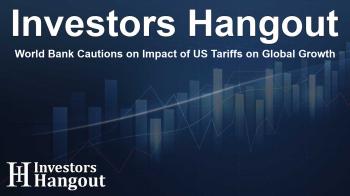World Bank Cautions on Impact of US Tariffs on Global Growth

World Bank Highlights Risks of US Tariffs
The World Bank has recently issued a cautionary report regarding the potential impact of proposed U.S. tariffs on global economic growth. These tariffs, which could be as high as 10%, have the potential to reduce a tepid global growth forecast by 0.3 percentage points by 2025, should trading partners retaliate with their own tariffs.
Implications for U.S. Growth
According to simulations conducted by the World Bank, if these tariffs are enforced, they could hamper U.S. economic growth, which is already predicted to be at 2.3% in 2025, potentially decreasing by 0.9%. However, there's a silver lining; if tax cuts are extended, there could be a modest increase of 0.4 percentage points in 2026, revealing the complex dynamics at play.
Trump's Proposed Tariffs
The incoming president is adamant about imposing tariffs, including a 10% levy on global imports and significantly higher tariffs on goods from Canada, Mexico, and China. These aggressive stances are expected to exacerbate the challenges already faced by the global economy.
Global Economic Growth Stagnation
The World Bank's Global Economic Prospect report lays out a gloomy outlook, predicting flat global economic growth of 2.7% for 2025 and 2026, a stark reminder of the persistent economic malaise that has gripped many regions. Factors contributing to this stagnation include long-term growth forecasts for developing economies, which now appear weaker than they have in over two decades.
Foreign Investment Challenges
Foreign direct investment in developing economies has decreased significantly compared to levels seen in the early 2000s, now standing at about half. Despite a growth projection of 4% for these economies in 2025 and 2026, this still falls short of pre-pandemic expectations owing to high debt levels, sluggish productivity, and costs stemming from climate change concerns.
Emerging Market Performance
It’s worth noting that overall output in emerging markets is anticipated to lag over 5% behind its pre-pandemic trajectory by 2026. This worrying trend highlights the gravity of the situation, as the repercussions of the pandemic and other shocks maintain a chokehold on these economies.
Warnings from Economic Analysts
Indermit Gil, chief economist at the World Bank, summarized the situation succinctly, saying, "The next 25 years will be tougher for developing economies than the last." This stark warning calls for urgent reforms and enhanced trade relations to support these vulnerable economies.
Widening Economic Disparities
The report indicates that the economic growth rates in developing nations dropped from nearly 6% in the 2000s to about 3.5% currently, suggesting an alarming trend of increasing disparity between affluent and poorer nations. The average growth rate per capita in developing countries, when excluding major players like China and India, has stagnated and is significantly lower compared to that of wealthier economies since 2014.
Future Risks to Economic Stability
As the World Bank points out, developing economies may face severe headwinds over the next couple of years, emphasizing the uncertainty prevalent in global policies. Rising trade tensions, high inflation, and fluctuating interest rates could greatly undermine investor confidence and financing flows, exacerbating the current economic challenges.
Looking Ahead
In conclusion, the World Bank's assessment serves as a crucial reminder of the interconnected nature of global economies. While policymakers are called to act decisively to mitigate these risks, it remains to be seen how successful they will be in fostering a more stable economic environment. The future may hold tough challenges, but with proactive reforms and cooperation, there's potential for a more promising economic trajectory.
Frequently Asked Questions
What is the World Bank's warning about US tariffs?
The World Bank warns that US tariffs could negatively impact global economic growth by reducing it by 0.3 percentage points.
How could tariffs affect US economic growth?
The report suggests that US growth could decline by 0.9% if retaliatory tariffs are enacted by trading partners.
What are the proposed tariffs by the US?
Proposed tariffs include a 10% tariff on global imports and significantly higher tariffs on imports from Canada, Mexico, and China.
What is the expected growth for developing economies?
Developing economies are projected to grow by 4% in 2025 and 2026, but this is below pre-pandemic estimates.
What risks do developing economies face?
Developing economies face risks such as high debt burdens, weak investment, and rising costs related to climate change, which threaten their growth.
About The Author
Contact Hannah Lewis privately here. Or send an email with ATTN: Hannah Lewis as the subject to contact@investorshangout.com.
About Investors Hangout
Investors Hangout is a leading online stock forum for financial discussion and learning, offering a wide range of free tools and resources. It draws in traders of all levels, who exchange market knowledge, investigate trading tactics, and keep an eye on industry developments in real time. Featuring financial articles, stock message boards, quotes, charts, company profiles, and live news updates. Through cooperative learning and a wealth of informational resources, it helps users from novices creating their first portfolios to experts honing their techniques. Join Investors Hangout today: https://investorshangout.com/
The content of this article is based on factual, publicly available information and does not represent legal, financial, or investment advice. Investors Hangout does not offer financial advice, and the author is not a licensed financial advisor. Consult a qualified advisor before making any financial or investment decisions based on this article. This article should not be considered advice to purchase, sell, or hold any securities or other investments. If any of the material provided here is inaccurate, please contact us for corrections.

